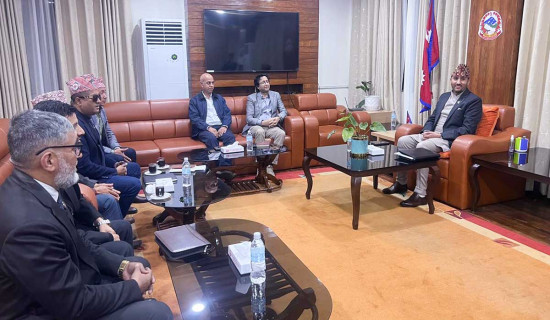- Wednesday, 17 December 2025
Managing Nepal-China Border Security
Nepal-China border security meetings are held time and again. Recently, a joint border security meeting was held between the chief district officer (CDO) of Humla and executive deputy commander of China-Nepal border law enforcement cooperation special joint political commissar of Purang at Taklakot of Tibetan Autonomous Region (TAR) of China. However, the local people of Humla Limi-Namkha frontier feel that the matter of border management was not discussed in the meeting.
Humla district of Nepal and Purang County of TAR of China share 263-kilometre border stretch. It is the longest border line among fifteen districts of Nepal that border with China. Along the border line, it has eleven main border pillars starting from No. 3 to 13. Pillar number 3 is located at Chimala Pass and number 13 at Namja Pass. In between, pillars 4 to 12 have been located at Numuche Tuppa, Kochyango, Kapathung, Siyarwa, Lambach, Hilsa, Changso, Takule and Lapche Pass, respectively.
Obstruction
Regarding the border management issue, Chinese border security force does not allow the local Nepali inhabitants to go to the Chinese frontier, whereas Chinese inhabitants can come to the Nepali frontier without any obstruction, ignoring the agreement that was done more than 50 years ago. Nepali frontier inhabitants were denied the permission to visit Mansarovar for the pilgrimage even by producing their citizenship certificates. Mansarovar Rakshastal is only 21 kilometres away from the border pass, located at Lapche pillar number 12.
Article VII of Agreement of Trade and Intercourse of May19, 1964 and Article 1.3 of May 2, 1966, mention that ‘Border inhabitants of the two countries, within an area of 30 kilometres from the border, who proceed to the border districts of the other country to carry on petty trade, to visit friends and relatives or for the seasonal change of residence, need not have passports, visas or other certificates, but shall register at the border check-post of the first encountered duly authorised government agency of the other country.’ This provision is ignored time and again by the Chinese side.
Secondly, the Nepali inhabitants of Limi-Namkha area of Humla district feel that their cattle are not permitted to the Chinese frontier for grazing, though it has been agreed by both the countries to allow it. Paragraph 2 of 'Minutes of the Nepal-China Joint Meeting on Trans-frontier pasturing by border inhabitants, September 30, 1983, states-- 'Some border inhabitants of Humla district of Nepal are permitted to cross the frontier for grazing on some of the pasture grounds to China's Purang. Some inhabitants of Purang are permitted to cross the frontier for grazing on the pasture grounds in Nepal's Humla district. The border inhabitants should pay 1.50 Yuan or 12 Nepali Rupees for each horse or mule, 100 grams of wool for each sheep or goat every pasturing season.’ In this context, Nepali local inhabitants are not happy that the agreement has not been followed.
The local residents of Humla Limi-Namkha area have a feeling that their forefathers used to take their sheep, yaks and horses beyond borderland for grazing. Obviously, they don't know, the border has been demarcated following the watershed ridge and hilltops and mountain passes. It is unfortunate that the local inhabitants were not informed that the watershed principle was adopted while demarcating the border.
On August 18, 2020, it was reported in the media from the local level that China had built eleven buildings in the Lapcha Lalungjong area of Humla Limi Rural Municipalilty-6, on the Nepali frontier. On July 10, 2021, a team consisting of Province Chief Minister and other officials inspected the pillar number 12 located at Lapcha Pass.
On this issue, Foreign Minister Pradeep Kumar Gyawali on September 24, 2020 said ‘Buildings built in the Nepal-China border region adjoining Humla Namkha municipality are located in the territory of China. We had sent a team for the field visit and study as the news had appeared in 2017’. According to the report presented by the joint team, the buildings were built by China within a kilometre on their side of the border.
Verification
Consequently, spokesperson of the Chinese Embassy in Nepal Wang Xiaolong had released a press statement, saying that 'China and Nepal have always respected each other’s independence, sovereignty and territorial integrity. The two countries have settled their border issue through friendly consultations as early as in the 1960s. China-Nepal border has since been free of dispute. Some individual forces earlier tried to hype up the so-called China-Nepal border dispute. It is proved that the Chinese construction is located within Chinese territory. Nepali side can verify.’ But it is not verified to the ground to satisfy the curiosity of frontier inhabitants.
In this context, it is relevant to form a joint team consisting of the representatives from both countries through the diplomatic channel. This joint team should visit the Limi-Namkha area to verify the border maps, observing the pillar by GPS coordinates in presence of district administration officials, representatives of local authorities, district political leaders and local inhabitants on both sides of the frontiers. It may help overcome the lingering doubts of the frontier inhabitants of that area regarding the border issue. Such verification will help strengthen the Nepal-China relations at the people-to-people level.
(The author is a border expert who has served as the director general of the Department of Survey.)

















